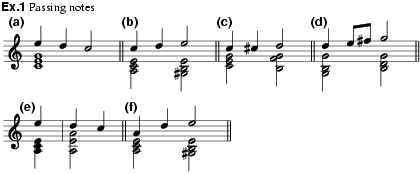
In part-writing, a note that is not consonant with the other notes of the chord with which it is sounded and must therefore be ‘resolved’, usually by step, to a note that is consonant. Non-harmonic notes are in a sense melodic ornaments, and many of the names used to describe them have been borrowed from the terminology for ornamentation (e.g. appoggiatura, broderie, Vorschlag). The following discussion is intended to clarify the meaning of the most important of these names as they are now used.
A passing note or passing tone (Ger. Durchgang) leads from one note to another in a single direction and by conjunct motion, supported either by a single or changing harmony (ex.1a–b), diatonically or chromatically (ex.1c), by itself or in pairs (ex.1d). Some writers restrict the term ‘passing note’ to unaccented notes only, preferring to call all accented non-harmonic notes appoggiaturas (see below); the expression ‘accented passing note’, however, is an acceptable description of ex.1e. Occasionally ‘free passing note’ is used for an unaccented non-harmonic note approached by leap and resolved in the same direction by step (ex.1f).

An anticipation is an unaccented note that belongs to and is repeated in the chord that immediately follows it (ex.2a). This term has been extended to include the notion of ‘rhythmic anticipation’, whereby the entire harmony on a strong beat is stated on the preceding weak beat, for instance at the beginning of the Minuet from Schubert’s Octet in F (outlined in ex.2b).
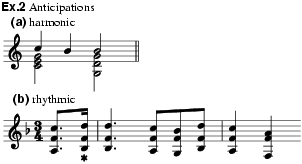
An auxiliary note (Fr. broderie; Ger. Hilfsnote) ornaments a ‘main note’ that lies a half or whole step above or below it by being approached from and returning to the main note, either singly (ex.3a), or in groups of two or three notes that may be said to form an ‘auxiliary chord’ (Ger. Hilfsklang; ex.3b). Auxiliary notes are sometimes referred to as ‘neighbour notes’ or ‘neighbouring notes’ but some writers following Schenker in his Der freie Satz (1935) restrict the lower neighbour to the note lying a half-step below the main note. In German the term Nebennote refers not only to the auxiliary note but to any other non-harmonic note that is approached from its main note by step.
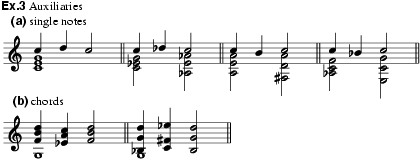
Some unaccented non-harmonic notes intervene in a melodic resolution but, unlike the passing note or the anticipation, are not contained in the interval circumscribing the resolution. When such a note is approached in the direction opposite that of the resolution it is called an ‘échappée’ (ex.4a), and when it is approached in the same direction – that is, when the resolution is ‘overshot’, so to speak – it is called a ‘cambiata’ (ex.4b). The term Nota cambiata is often confused with ‘cambiata’ when it is used as a noun; it would be preferable to restrict the former to a particular group of configurations in which an unaccented non-harmonic note is quitted by downward leap of a 3rd.
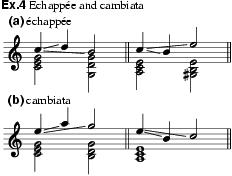
Any non-harmonic note that occurs on a relatively strong beat is an appoggiatura (Fr. appoggiature; Ger. Vorschlag), though it is generally understood that the note must be articulated on that beat, as in ex.5a–e; when it is tied over, as a consonant note, from the previous chord (ex.5f) it is called a Suspension(Fr. suspension; Ger. Vorhalt; It. sospensione). An appoggiatura is often approached by leap, either in the same direction as the resolution (ex.5a) or the opposite one (ex.5b); or it may be an accented passing note, diatonic (ex.5c) or chromatic (ex.5d). When it occurs in the previous chord as a consonant note but is not tied over, it is called a prepared appoggiatura. Because they are accented, appoggiaturas form the most expressive category of non-harmonic notes. Moreover, they usually tend towards a specific note of resolution and thus create an expectation which is fulfilled in their resolution; the simplest diatonic resolution, for instance that of the leading note to the tonic, becomes the most vivid of melodic progressions when approached by leap and presented in a strong-to-weak rhythmic position, as in ex.6.
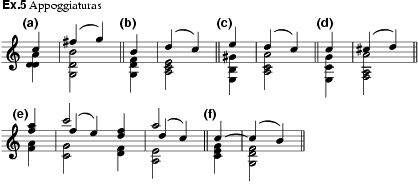

WILLIAM DRABKIN